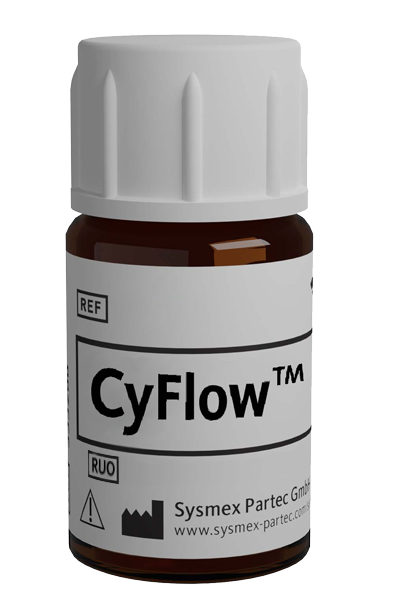CyFlow™ CD105 FITC

| Alternative Name: | Endoglin |
| Antibody: | Yes |
| Antigen: | CD105 |
| Application: | Flow cytometry |
| Clonality: | monoclonal |
| Clone: | MEM-226 |
| Emission Maximum: | 518 nm |
| Excitation Maximum: | 490 to 495 nm |
| Field of Interest: | Immunophenotyping |
| Format/Fluorochrome: | FITC |
| Isotype: | IgG2a |
| Laser: | Blue |
| Regulatory Status: | RUO |
| Source Species: | Mouse |
| Target Species: | Human, Rat |
| Product number: | CV407370 |
For Research Use Only
| Quantity | 100 tests |
| Volume | 2.0 mL |
| Immunogen | Recombinant Vaccinia virus containing the human CD105 cDNA |
| Background Information | CD105 (Endoglin) is a homodimeric transmembrane glycoprotein serving in presence of TGFβR-2 as a receptor for TGFβ-1 and TGFβ-3. CD105 is highly expressed on endothelial cells and promotes angiogenesis during wound healing, infarcts and in a wide range of tumours and its gene expression is stimulated by hypoxia. CD105 prevents apoptosis in hypoxic endothelial cells and also antagonizes the inhibitory effects of TGFβ-1 on vascular endothelial cell growth and migration. Normal cellular levels of CD105 are required for formation of new blood vessels. |
| Usage | The reagent is designed for Flow Cytometry analysis of human blood cells. Recommended usage is 20·µl reagent·/ 100·µl of whole blood or 10^6 cells in a suspension. The content of a vial (2 ml) is sufficient for 100 tests. |
| Storage Buffer | The reagent is provided in stabilizing phosphate buffered saline (PBS) solution, pH ≈7.4, containing 0.09% (w/v) sodium azide. |
| Storage | Avoid prolonged exposure to light. Store in the dark at 2-8°C. Do not freeze. |
| Stability | Do not use after expiration date stamped on vial label. |
| Li C, Issa R, Kumar P, Hampson IN, Lopez-Novoa JM, Bernabeu C, Kumar S: CD105 prevents apoptosis in hypoxic endothelial cells. J Cell Sci. 2003 Jul 1; 116(13):2677‑85. < PMID: 12746487 > | Zhu Y, Sun Y, Xie L, Jin K, Sheibani N, Greenberg DA: Hypoxic induction of endoglin via mitogen‑activated protein kinases in mouse brain microvascular endothelial cells. Stroke. 2003 Oct; 34(10):2483‑8. < PMID: 12947156 > | Guo B, Slevin M, Li C, Parameshwar S, Liu D, Kumar P, Bernabeu C, Kumar S: CD105 inhibits transforming growth factor‑beta‑Smad3 signalling. Anticancer Res. 2004 May-Jun; 24(3a):1337‑45. < PMID: 15274293 > | Warrington K, Hillarby MC, Li C, Letarte M, Kumar S: Functional role of CD105 in TGF‑beta1 signalling in murine and human endothelial cells. Anticancer Res. 2005 May-Jun; 25(3B):1851‑64. < PMID: 16158917 > | Piao M, Tokunaga O: Significant expression of endoglin (CD105), TGFbeta‑1 and TGFbeta R‑2 in the atherosclerotic aorta: an immunohistological study. J Atheroscler Thromb. 2006 Apr; 13(2):82‑9. < PMID: 16733295 > | Schmidt D, Achermann J, Odermatt B, Breymann C, Mol A, Genoni M, Zund G, Hoerstrup SP: Prenatally fabricated autologous human living heart valves based on amniotic fluid derived progenitor cells as single cell source. Circulation. 2007 Sep 11; 116(11 Suppl):I64‑70. < PMID: 17846327 > | Asumda FZ, Chase PB: Age‐related changes in rat bone‐marrow mesenchymal stem cell plasticity. BMCCellBiol. 2011 Oct 12; 12:44. < PMID: 21992089 >
